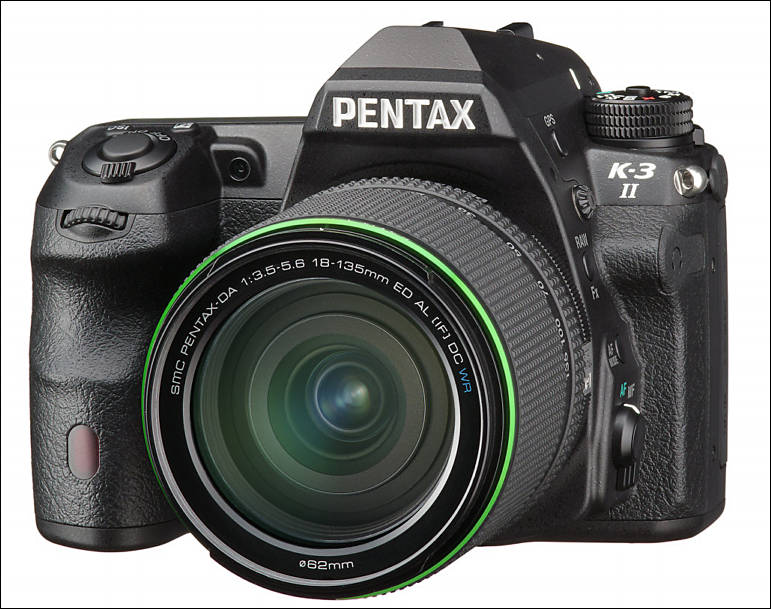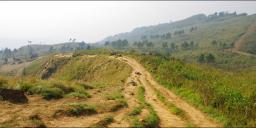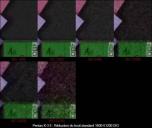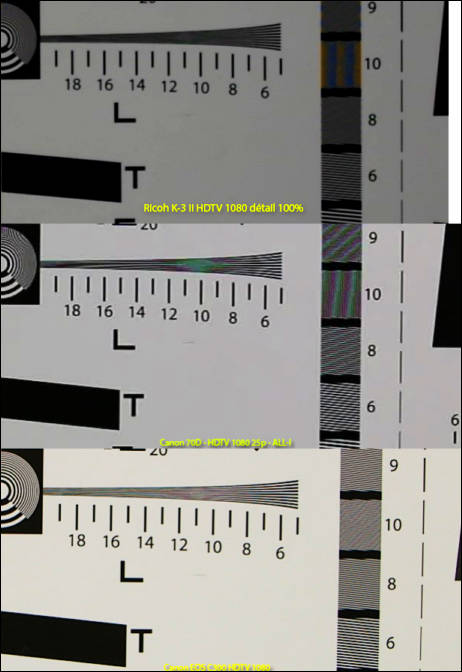
-

Available at http://www.amazon.com/Pentax-K-3II-DSLR-Body-Only/dp/B00WBIYADC/
RICOH is proud to introduce the PENTAX K-3 II Digital SLR; refining the ultimate field camera. Developed as the successor to the award winning PENTAX K-3, the new K-3 II shares its predecessor’s magnesium alloy casing, metal chassis, 24.35 effective megapixel resolution, 27-point AF system and approximately 8.3 frames per second shooting while adding an improved 4.5EV stop shake reduction system, new high-speed AF algorithm, GPS, gyro sensor panning detection and automatic horizon correction.
"The introduction of the PENTAX K-3 II marks our commitment to providing photographers with rugged high quality solutions that exceed our customers’ expectations,” said Jim Malcolm, President of Ricoh Imaging Americas Corporation. The “magic’’ we add to our cameras through the motion-controlled Shake Reduction (SR) technology helps our photographers shoot for the stars and capture images in stunning detail; no other manufacturer is offering such a variety of features in a single camera design.”
The K-3 II is the first camera in the PENTAX line to incorporate Pixel Shift Resolution® for capturing still life subjects with ultra-high resolving power. Pixel shift technology uses the camera’s in-body Shake Reduction mechanism to move the image sensor at single pixel increments, capture 4 separate images, which are subsequently combined into a single high definition image. Benefits include higher resolving power, reduced false color and improved overall image quality of non-moving subjects.
Building on the PENTAX K-3 camera’s rugged dust proof and weather-resistant construction, the K-3 II features a built-in GPS receiver, GPS log and electronic compass purpose- designed to stand up to demanding location work. The GPS system records shooting location, camera orientation, altitude, and provides a date/time stamp tied specifically to your images; all of which can be transferred to a computer and mapped using services such as Google Earth™.
By combining the power of GPS positioning with in-body shake reduction mechanism, the PENTAX K-3 II cameras exclusive built in ASTROTRACER® features tracks and photographs astronomical bodies such as stars and planets. The system uses GPS and orientation location data together with magnetic and acceleration sensors to calculate the motion needed to synchronize the CMOS sensor with the movement of the stars; making it possible to capture stars as points of light rather than star trails during long exposures.
“The original PENTAX K-3 has been my go to camera since it was first introduced,” said professional photographer Kerrick James. “Now with the addition of GPS, Pixel Shift Resolution, and 4.5EV stop shake reduction, my field photography is further refined and documented regardless of my remote location. This ensures my demanding shooting style will always be met and will provide my clients with consistently high quality photography.”
The new PENTAX K-3 II uses the advanced and intuitive user interface common to most PENTAX camera products. The system is compatible with a host of accessories including a versatile array of flash units, lenses, battery grip and interchangeable focus screens.
Pricing and Availability
The PENTAX K-3 II will be available in May 2015 for a suggested retail price of $1099.95.
1. High-resolution images
The K-3 II combines an APS-C-size CMOS image sensor free of an anti-aliasing filter with the high-performance PRIME III imaging engine — identical to the one installed in the PENTAX 645Z medium-format digital SLR camera — to optimize the imaging power of approximately 24.35 effective megapixels and deliver sharp, fine-gradation images. It also effectively minimizes annoying noise generated at higher sensitivities, allowing high-grade, high-sensitivity shooting even at the top sensitivity of ISO 51200.
2. New-generation PENTAX-original shake reduction mechanism
(1) Upgraded in-body SR mechanism to assure the best shake reduction performance in the K series
The K-3 II comes equipped with a PENTAX-developed SR (Shake Reduction) mechanism that can be used with any compatible PENTAX interchangeable lens.* Thanks to its new, high-precision gyro sensor, this mechanism assures more stable, effective camera-shake compensation than ever before, with an extra-wide compensation range of as much as 4.5 shutter steps — the widest of all K-series digital SLR models. Even when taking a panning shot, this efficiently controls the SR unit to always produce the best image possible under the given conditions.
(2) New Pixel Shift Resolution System to deliver image resolutions higher than the image sensor’s capacity
The K-3 II features Pixel Shift Resolution System,** the latest super-resolution technology, which captures four images of the same scene by shifting the image sensor by a single pixel for each image, then synthesizes them into a single composite image. Compared to the conventional Bayer system, in which each pixel has only a single unit of color data, this new system obtains all color data in each pixel. This innovative system delivers super-high-resolution images with far more truthful color reproduction and much finer details, while significantly lowering the level of high-sensitivity noise. Recorded images can also be synthesized, either on a computer using the accompanying utility software, or with the camera’s in-body RAW-data development function.
(3) Innovative AA filter simulator to minimize moiré
By applying microscopic vibrations to the image sensor unit at the sub-pixel level during image exposure, the K-3 II’s AA (anti-aliasing) filter simulator*** provides the same level of moiré reduction as an optical AA filter. Unlike an optical filter, which always creates the identical result, this innovative simulator lets the user not only switch the anti-aliasing filter effect on and off, but also to adjust the level of the effect. This means that the ideal effect can be set for a particular scene or subject.
(4) Supportive shooting functions
The K-3 II’s SR unit has a flexible design that tilts the image sensor unit in all directions. This is one reason why the K-3 II can provide a host of handy shooting functions, including auto level compensation; image-composition fine-adjustment; and ASTROTRACER, which simplifies advanced astronomical photography.
3. High-precision, SAFOX 11 sensor module with 27-point AF system
The K-3 II features the sophisticated SAFOX 11 AF sensor module with an expanded image-field coverage using 27 AF sensors (25 cross-type sensors positioned in the middle). The center sensor and the two sensors just above and below it are designed to detect the light flux of an F2.8 lens, making it easy to obtain pinpoint focus on a subject when using a large-aperture lens. Thanks to the combination of a state-of-the-art AF algorithm and the advanced PENTAX Real-Time Scene Analysis System, this AF system assures much improved AF tracking performance in the AF Continuous mode, while providing an extra-wide measurable luminance range (–3EV to +18EV).
4. High-precision exposure control with PENTAX Real-Time Scene Analysis System
The K-3 II is equipped with the advanced PENTAX Real-Time Scene Analysis System, which is supported by an approximately 86,000-pixel RGB metering sensor. This system is designed to optimize the camera’s overall performance, not only by controlling exposure with great accuracy, but also by utilizing the data obtained by the light-metering sensor to further enhance the accuracy of autofocusing and white-balance adjustment. It has also expanded the measurable luminance level to as low as –3EV. By detecting the type of scene or subject using the RGB metering sensor, the K-3 II selects the exposure settings that are more consistent with the photographer’s creative intentions.
5. High-speed continuous shooting with a top speed of approximately 8.3 images per second
The K-3 II continuously records as many as 23 images in the RAW format, or 60 images in the JPEG format,**** in a single sequence. This has been made possible through the use of several innovative developments, including: a high-speed, highly accurate control mechanism that regulates the shutter, mirror and diaphragm independently; a damper mechanism that effectively minimizes mirror shock; and a high-speed data transmission system incorporated in the PRIME III imaging engine.
6. Optical viewfinder with nearly 100-percent field of view
The K-3 II’s glass prism has been treated with a coating that is designed to improve reflectance for a much brighter viewfinder image. With a magnification of approximately 0.95 times, its viewfinder provides a broad, bright image field for easy focusing and framing.
7. Full HD movie recording with an array of creative tools
The K-3 II captures Full HD movie clips (1920 x 1080 pixels; 60i/30p frame rate) in the H.264 recording format. It also comes equipped with a stereo mic terminal for external microphone connection and a headphone terminal. The user can even adjust the audio recording level manually and monitor sound pressure levels during microphone recording. In addition to a host of distinctive visual effects available for movie recording,***** the K-3 II also provides the interval movie mode, which captures a series of 4K-resolution movie clips at a fixed interval
8. Built-in GPS module
Thanks to its built-in GPS module, the K-3 II provides a variety of advanced GPS functions, including the recording of location, latitude, longitude, altitude and UTC (Universal Time Coordinated) and direction at the time of shooting. The user can easily access images containing GPS data using a computer, to browse them, check on shooting locations and position data on the screen, or save them. The user can also take advantage of some unique tools, including: GPS log, which keeps track of the photographer’s movement; Electronic Compass, which displays the camera’s direction on the camera’s LCD monitor; and ASTROTRACER, which simplifies the tracing and photographing of celestial bodies by coupling GPS data with the camera’s SR mechanism.
9. Large, easy-to-view 3.2-inch LCD monitor with approximately 1,037,000 dots
On its back panel, the K-3 II features a 3.2-inch high-resolution LCD monitor with approximately 1,037,000 dots and a 3:2 aspect ratio. In addition to its wide-view design, this monitor also has a protective tempered-glass front panel for added durability, and a unique air-gapless construction in which the air space between LCD layers is eliminated to effectively reduce the reflection and dispersion of light for improved visibility during outdoor shooting.
10. Compact, solid body with dustproof, weather-resistant construction
The K-3 II’s exterior casing, consisting of top and bottom panels and front and back frames, is made of sturdy yet lightweight magnesium alloy. Thanks to the inclusion of 92 sealing parts in the body, it boasts a dustproof, weather-resistant and cold-resistant construction, assuring solid operation at temperatures as low as –10°C. It also features a dependable, durable shutter unit that withstands 200,000 shutter releases. Despite all these features, the K-3 II has been designed to be compact and maneuverable, assuring remarkable operability and swift response in the field.
11. Other features
- Dual SD card slots for memory card flexibility (compatible with SDXC UHS-1 speed class in SDR104 buss speed mode)
- Smartphone-support functions using the optional FLUCARD FOR PENTAX 16GB
- Top-grade DRII (Dust Removal II) mechanism for effective elimination of dust on the image sensor using ultrasonic vibration
- HDR (High Dynamic Range) shooting mode with RAW-format data filing
- PENTAX-invented hyper control system for quick, accurate response to the photographer’s creative intentions
- Model dial with a choice of lock mechanism engagement (ON or OFF)
- Compensation of various parameters: lens distortion, lateral chromatic aberration, diffraction, brightness level at image-field edges, and fringe effect (available in RAW-format processing only)
- The latest version of Digital Camera Utility 5 software is included
- Dual SD card slots for memory card flexibility (compatible with SDXC UHS-1 speed class in SDR104 buss speed mode)
-
I have always have a soft spot for pentax cameras. I love the color and image quality coming from their sensors. I came very close to getting the K-3. For me it's between pentax and nikon. Will like to see how this stacks up against the nikon D7200. Maybe I can get one of these to use as my travel photo camera. I will keep an eye on this camera and see.
-
Here is the first alternative implementation to Foveon sensor using pixel shift to capture all colors at each pixel.
What is not clear is how fast can it capture 4 photos, faster than or same as Olympus? Olympus uses pixel shift to capture 40MP images of static objects.
-
Its too bad pentax doesn't have video in the corporate dna. I shoot all stills with pentax (k100ds was my first now on a k30 that I love!) and have a ton of mf pentax glass that I adapt on a gh2 my friend owns.
Given the hole Canon has decided to leave in the enthusiast dslr video space pentax could dive into the space and capture some of what is available.
-
Given the hole Canon has decided to leave in the enthusiast dslr video space pentax could dive into the space and capture some of what is available.
Ricoh won't do it. I think last straw can be failed FF camera that they will try to sell for around $2500-3000.
Only two companies have everything to win on long term - it is Samsung and Sony.
-
Only two companies have everything to win on long term - it is Samsung and Sony.
Really, you think Samsung cameras have that much promise? Time to go start buying some samsung stocks lol. Sony, yes I can see that.
-
Really, you think Samsung cameras have that much promise?
Samsung is huge monster, and their last sensors and cameras are quite good. Plus only Samsung and Sony run more or less full fledged Linux as camera OS (in Samsung it is Tizen on top of it).
-
Plus only Samsung and Sony run more or less full fledged Linux as camera OS
True true, but that's not necessarily gonna transform to cameras sold though. Well I will take it back, maybe in the long run like you said.
-
True true, but that's not necessarily gonna transform to cameras sold though. Well I will take it back, maybe in the long run like you said.
Things will change significantly very soon. As soon as people will realize that standard camera OSes can bring huge progress it will change everything.
-
Ricoh bread and butter is its B2B and is trying to find some growth on the B2C which includes cameras. I believe Ricoh is pursuing growth aiming at select niches in photography. The medium format 645Z is selling very well, much better than forecasts. The GR is also holding up even though it was launched 2 years ago. Hard to say how its next FF will fare. My bets will be after this FF will come a GR FF. If it is me, I would update the 28mm and 21mm they had in their film GR1 and GR21. Photographers are their core customers. As to Samsung, growth in high end cameras is one dimension they are trying to offset the margin loss on their smartphones. Tizen is another dimension, there are others. It is unclear if any of these can truly offset the smartphone side. If not, then the strategies will be relooked at. After all, in SSE, there is an annual reorg at the executive/vp/svp levels. That pressure to restructure is also heavy and on.
-
I get Ricoh's position but they need to understand that an FF will be adopted by some users who shoot for pay esp events weddings etc. Nowadays that user is also quite often shooting video as well.
Wouldn't hurt to offer them decent 1080p video quality with focus peaking would it?? At least on par with hacked gh2 quality.
-
Wouldn't hurt to offer them decent 1080p video quality with focus peaking would it?? At least on par with hacked gh2 quality.
Must be too much for them :-)
In reality, Pentax demise started from simple fact that they did not have enough engineers and experience. They worked very hard, made many very good things, but constantly lagged in main LSI design.
Sony and Samsung already can make breakthrough offering 60fps using full sensor resolution (20-28Mpix). Sensors can do it, LSI can be made highly parallel, DRAM and SSD speed are also up to the task. But they are afraid now, as they need to sell you cameras year after year.
-
I think Ricoh may be willing to take some risks since they have seen some turn around in the Pentax brand since taking over. However they seem to see Asia as their core market and I'm not sure if that market has the energy and demand for enthusiast film maker quality video or not.
-

 phantom33.jpg800 x 395 - 68K
phantom33.jpg800 x 395 - 68K -

 sales57.jpg800 x 494 - 64K
sales57.jpg800 x 494 - 64K -

 sales145.jpg598 x 502 - 39K
sales145.jpg598 x 502 - 39K -

Pentax continue to offer rugged, weather resistant DSLRs that offer outstanding image quality at a very attractive price. Coupled with high quality lenses, this continues to be a winning combination. The new Pixel Shift Resolution feature looks like a winner and the inclusion of GPS and Astrotracer will be welcomed by many.
http://www.ephotozine.com/article/pentax-k-3-mark-ii-review-27743

 sales146.jpg800 x 545 - 54K
sales146.jpg800 x 545 - 54K -

The Pentax K-3 II continues to be the most full-featured prosumer DSLR camera on the market at its new price-point, delivering great performance, weather-resistant build quality, slick handling and excellent image quality yet costing several hundred pounds/dollars less than the Nikon/Canon equivalent.

 sales147.jpg800 x 648 - 134K
sales147.jpg800 x 648 - 134K -
At Ricoh, we are dedicated to delivering superior technology, quality products and unyielding customer service. Continuing this commitment, we are contacting PENTAX K-3 II camera owners, as we’ve learned that in some situations the camera will not turn off, even after the power lever is moved to the OFF position. This anomaly is limited to cameras with a serial number below #6206660.
Customers with K-3 II camera serial numbers lower than #6206660* requiring support should call 1-800-234-0276 to have the camera inspected and serviced free of charge, even if the product appears to be functioning properly.
We greatly appreciate our customers’ patience as we are committed to making it a seamless process and providing the highest level of service and support.
Excluded Serial Numbers:
K-3 II Products with the following serial numbers are not subject to this service:
6199671, 6187961-6188110, 6192376-6192380, 6192386-6192390, 6192436-6192440, 6196362- 6196369, 6196661-6196960, 6197748-6197750, 6197768-6197770
-

 sales88.jpg800 x 510 - 93K
sales88.jpg800 x 510 - 93K -

 tamron14.jpg800 x 522 - 71K
tamron14.jpg800 x 522 - 71K -

 zebra168.jpg462 x 672 - 40K
zebra168.jpg462 x 672 - 40K -
Like the K-3, the K-3 II delivered excellent color accuracy in our Imatest tests, with JPEGs showing similar characteristics to the DNG.RAW files we converted into TIFF format with Adobe Camera Raw.
The Pixel Shift Resolution function was quite impressive. Like the original K-3, the new camera is a pleasure to shoot with and its menu system is well designed and easy to read.
The integrated GPS module will be handy for travellers and we doubt many photographers would miss the built-in flash as the one in the previous model was quite weak. Continuous shooting speeds are fast enough to satisfy sports and wildlife photographers and the generous buffer memory deserves commendation.
http://photoreview.com.au/reviews/dslr-cameras/advanced/pentax-k-3-ii
Howdy, Stranger!
It looks like you're new here. If you want to get involved, click one of these buttons!
Categories
- Topics List23,992
- Blog5,725
- General and News1,354
- Hacks and Patches1,153
- ↳ Top Settings33
- ↳ Beginners256
- ↳ Archives402
- ↳ Hacks News and Development56
- Cameras2,367
- ↳ Panasonic995
- ↳ Canon118
- ↳ Sony156
- ↳ Nikon96
- ↳ Pentax and Samsung70
- ↳ Olympus and Fujifilm101
- ↳ Compacts and Camcorders300
- ↳ Smartphones for video97
- ↳ Pro Video Cameras191
- ↳ BlackMagic and other raw cameras116
- Skill1,960
- ↳ Business and distribution66
- ↳ Preparation, scripts and legal38
- ↳ Art149
- ↳ Import, Convert, Exporting291
- ↳ Editors191
- ↳ Effects and stunts115
- ↳ Color grading197
- ↳ Sound and Music280
- ↳ Lighting96
- ↳ Software and storage tips266
- Gear5,420
- ↳ Filters, Adapters, Matte boxes344
- ↳ Lenses1,582
- ↳ Follow focus and gears93
- ↳ Sound499
- ↳ Lighting gear314
- ↳ Camera movement230
- ↳ Gimbals and copters302
- ↳ Rigs and related stuff273
- ↳ Power solutions83
- ↳ Monitors and viewfinders340
- ↳ Tripods and fluid heads139
- ↳ Storage286
- ↳ Computers and studio gear560
- ↳ VR and 3D248
- Showcase1,859
- Marketplace2,834
- Offtopic1,320
Tags in Topic
- pentax 48










